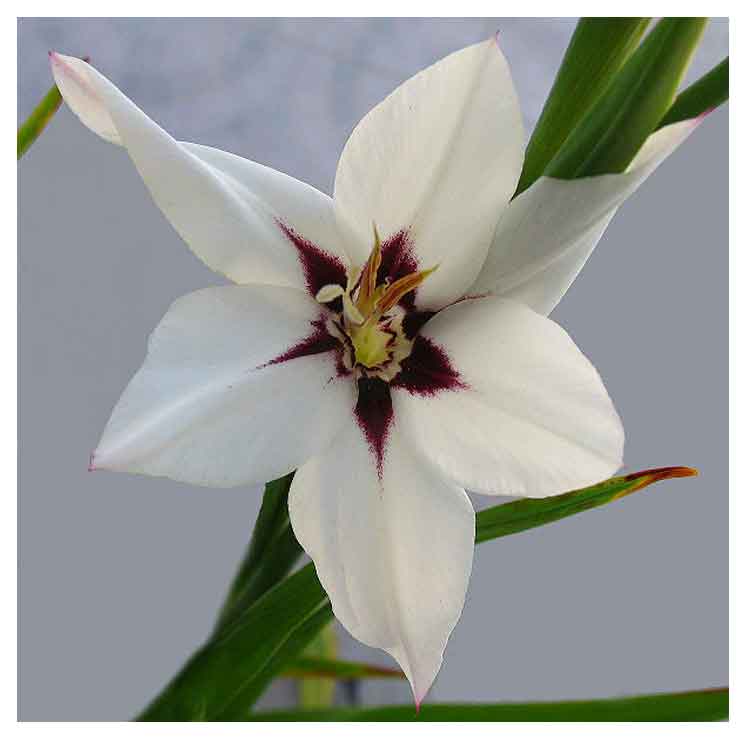|
 General info General info
- The genus Gladiolus consists of about 250 to 300 species of perennial corms.
-
Gladiolus is the flower for the month
of August.
- Genus latin name means "small sword," referring to the shape
of the leaves.
- The old name for gladiolus was xiphium, of Greek origin, meaning "sword."
- Thousands of varieties have been derived from the common gladiolus.
Botany
Gladiolus is a genus of perennial bulb bearing medium-sized herb. Leaves are sword-shaped, arising at or near ground, clasping the stem. Flowers are several and usually clustered, tubular, trumpet- or funnel-shaped, pink, white, yellow
or orange, up to 10 centimeters across and borne on a simple and branched spike, up to two dozens on a single stem.
Petals are funnel-shaped, enlarging upward; lobes are six, unequal and
narrowed at the base; the upper lobes hooded at the opening of the mouth.
Distribution
- Most of the Philippine cultivars are of hybrid origin.
- Prefers the cool places of Batangas, Mountain Province, and the highlands of Cebu.
- Many originated from sub-Saharan Africa, mostly South Africa. Some originate from the Mediterranean.
- Found wild in west and central Europe, to southwest and central Asia.
 Constituents Constituents
- Phytochemical analysis of aqueous extracts of corms yielded alkaloids, tannins, saponins, cardiac glycosides, flavonoids and carbohydrates.
- Study of aerial parts of Gladiolus gandavensis isolated ten compounds: kaempferol, apigenin-7-O-alpha-L-rhamnoside, tamarixetin-3-robinobioside, nicotiflorin, astragalin-2"-O-beta-D-glucopyranoside, quercetin-3-O-(6"-O-Ecaffeoyl)-beta-D-glucopyranoside, beta-sitosterol, daucosterol, isopentylgentiobioside, and glycerol-alpha-monohexacosanate. (4)
- Study on three fractions of the bulbs of Gladiolus gregasius Baker showed that they all contained alcaloids, triterpenes, sterols, anthraquinones, glycosides and cardiac glycoside. (5)
Parts used
Corms, leaves.
Uses
Edibility
• Corms of Gladiolus dalenii are used as food in Zaire. Starchy croms are boiled and leached in water before consumption. Corm of G. edulis Burch also reported as edible.
Folkloric
• No reported folkloric
use in the Philippines.
• In sub-Saharan Africa, prescribed as a booster for patients with low energy and for hypochondriacs.
• In southern Africa,
used for diarrhea and colds; a component of "lenaka."
• In West A frica, used for both constipation and dysentery.
• In South West Nigeria, corms are used in treating gonorrhea, dysentery, and other infectious conditions.
• Corms ground to a fine meal to treat dysentery, diarrhea
and stomach upsets.
• The Zulu use the corm of G. ludwiggi Pappe in making a medicine to facilitate placental passage. Corm decoction also used as enema to relieve dysmenorrhea.
• In southern Africa, corm used as remedy for impotency.
• In Ghana, corms are mixed with ginger as evacuant for constipation and dysentery.
• Decoction of corm used for rheumatic pains.
source
• KwaZulu-Natal
use an infusion of corms and lower portion of leaves for coughs and
colds. Flower petals crushed into a ball rubbed onto nails to strengthen
them. Infusion of petals warmed by the sun used as soothing wash for
tired feet. source
• Poultice of corms used to draw out splinters and thorns.
source
• In the 17th century, the British used ground and powdered corm,
mixed with goat's milk, for colicky babies. source
Others
• Ritual: - In China, a flower for ceremonies and funerals; believed to help people
find their way to their heaven.
Studies
• Antimicrobial: Study evaluated aqueous extracts of corms obtained in Nigeria for antimicrobial effects. Results showed activity against Pseudomonas aeruginosa and Aspergillus niger, but relatively inactive against other organisms. Phytochemical analysis yielded alkaloids, tannins, saponins, cardiac glycosides, flavonoids and carbohydrates. The presence of cardiac glycosides poses a concern for use in any formuation. (3)
• Antimicrobial: In a study of five medicinal plants, including Gladiolus gregasius Baker, all exhibited antibacterial and anticandidal activities. Results suggest potential use for treatment of various urogenital and gastrointestinal ailments caused by multiresistant microbial agents. (5)
• Anticandidal / Saponins / Toxicity Study: A hydroethanolic 80% extract of bulbs of Gladiolus gregasius Baker showed a high degree of anti-candidal activity against Candida albicans and C. krusei. The extract had no activity against tested bacteria. Phytochemical screening yielded an important saponin conten which may explain its anticandidal property. Evaluation of acute toxicity on male rats showed the crude extract to be non-toxic. (6)
Availability
Cultivated.
|


 General info
General info Constituents
Constituents

